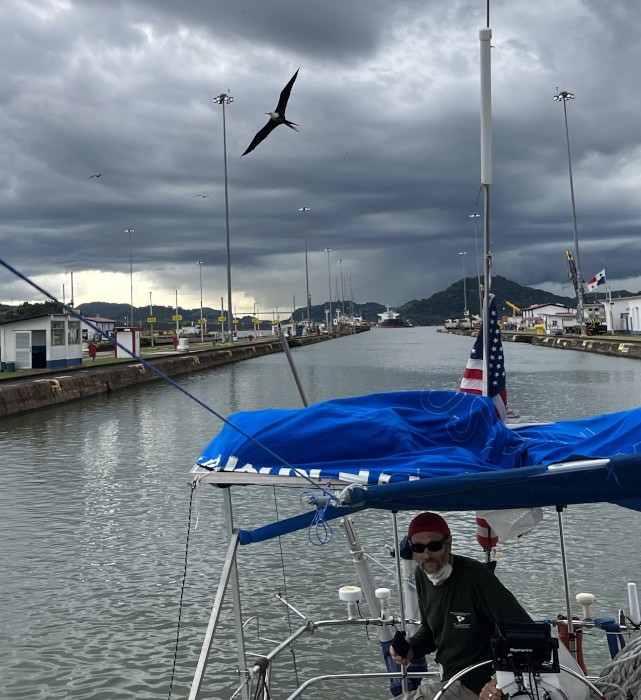To Reach a New Ocean
13 June 2022
• Balboa Yacht Club Balboa Panama
by robin

Near the marina at Diablo Beach a parade green leaves walked up and over Karl’s foot. When we looked closely, they were ants carrying leaf fragments in a long line that disappeared into the bushes. Creative ecosystems and human engineering dominate the landscape here. First motivated by gold and the bad weather in Patagonia, humans have move tremendous loads between oceans in Panama. Yesterday we pulled up our anchor off of Shelter Bay Sunday evening to join that modern ant parade moving from the Atlantic to the Pacific.
The lock parade choreography is quite simple. For each lock the movements are (1) Move floating vehicle into water filled box, (2) tie vehicle up to the box edges, (3) close box, (4) add or drain water (5) open box and (6) floating vehicle departs either higher or lower. Transiting the Panama Canal involves three steps up in boxes(lock) filling, driving through a crocodile filled lake in the jungle the three steps down. In the dark on Sunday night we did the three up locks with whirlpools and bouncing currents. Today, after a cup of coffee seated on the giant mooring buoy, we drove across Lake Gatun. Then the three steps down where the water drained quietly like a bathtub. The dance steps in each lock ensure the vehicle (sailboat or huge cargo ship), does not smash into the side of the box/lock. For small boats like us a thin rope with a giant knot at the end (monkeys’ fist), is thrown from shore by men in orange helmets and life vests. The thin rope is tied to the heavy strong blue mooring lines (ropes) on the Mable Rose and pulled to shore by the helmeted men. Giant electric train engines and wires are the equivalent for the cargo ship. For sailboat the helmeted men position the boat by walking along the edge of the lock and between locks running up and down large staircases. For large ships the electric mules move along a railway ringing bells and tightening wire dragging the vessel that has about 2 feet to spare on either side through the lock.
Like with any parade behind the obvious players such as the helmeted men tossing lines and the drivers of the electric mules are complicated planning and engineering efforts and also ecosystem consequences. Men quietly raked leaves as the ships were pulled along the lock as the towering container ship passes silently. People leave their offices for coffee chatting and laughing. Uniformed teams lugging buckets and mops walk across the lock doors to towards the building on the far side. The familiar shaped red and green buoys marking the edge of the channel reflect the American influence on the canal. People in white hazmat suits stand on the front (bow) of small black workboat using a high pressure hose to remove any evidence of the birds who perch and nest there. The canal is central to Panama. Our pilot/advisor used the pronoun we whenever he speaks of how the canal was built and maintained. SO much maintenance. Along the edge of the canal in the narrow “cuts” the mountains are stair stepped. It resembles stairsteps in the topography along the Cuban edge of the Windward Passage where the earth through millions of years of earthquakes had uplifted the mountain. While the rock on the canal edge tell stories up volcanos and uplift these stair steps are not uplift. The force at work is human removing mountains to move gold, cars, oil, the Mabel Rose and many other things. These are stair steps on the mountains were carved by humans. Dump trucks and backhoes are still grinding away making steps in the landscape. Other parts the canal banks have the vertical scars from blasting with dynamite. The natural ecosystems have also adapted to the engineering. At the last lock Magnificent Frigate birds perform aerial battles over fish. These locks are easy fishing. Lake fish who swim into the lock are stunned salt water. Chemically out of balance they float to the top, an easy meal. As we emerge into Pacific a crocodile on the left is also fishing. While the lake between the locks look natural, we were warned not to leave the channel. The drowned trees are waiting to seek revenge a reminder we are sailing over what was a jungle.
The ants cannot see the extent of the jungle where they harvest and transport leaves. While the humans who dreamed of the canal also could not see the edges of the jungle or understand how the global systems work. Humans do. The ant parade we joined today was moving cars, gas, chemicals and containers. I am hopeful when I see wind turbines towers moving towards the Atlantic. The process is remarkable as the water the rainy jungle lifts us from our Atlantic home and lowers us to a new ocean there the lock doors open to the Pacific.
Bird Note 1: The birds love the canal buoys. This morning we saw Brown Boobies, maybe a crested caracara and a greater caracara perching on the yellow buoy also next to us. A large family of Sandwich terns rested on the inflatable orange mooring buoy between the mabel rose and the other sailboat, Sea Angel.
Bird Note 2: The birds love the free fishing at the last locks on either side. Now realize that is why there were Magnificent Frigate birds greeting us at sunset as we entered the Canal in Colon. Stand on the edge of the lock doors were egrets (cattle and white), fishing when the water is high and looking disappointed when the water drops.



Comments